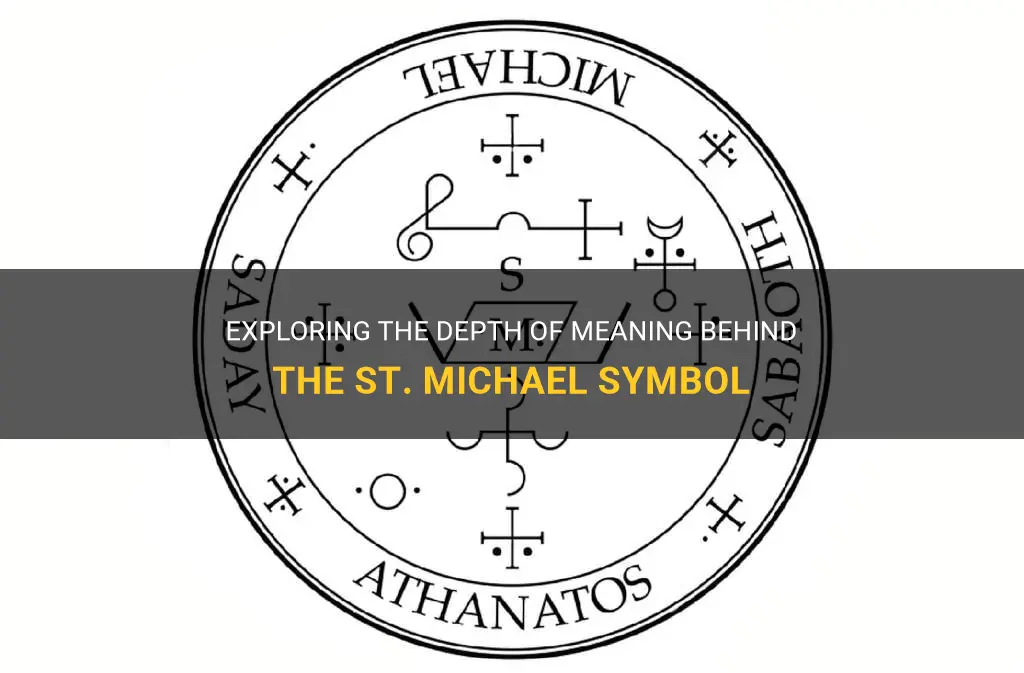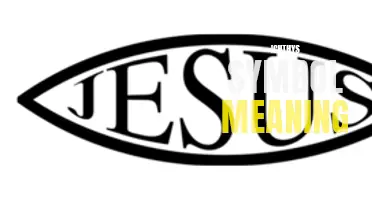
The symbol of St. Michael holds great significance and meaning, as it represents the epitome of righteousness, strength, and protection across various cultures and religions. From appearing in religious texts to being depicted in art and architecture, the figure of St. Michael carries a deep symbolism that transcends time and connects people with their faith and the divine. In this article, we will delve into the rich history and multifaceted meanings behind the symbol of St. Michael, exploring its origins and how it continues to inspire and empower individuals today.
What You'll Learn
- What is the symbolic meaning of the St. Michael's symbol?
- How is St. Michael depicted in different cultures and religions?
- What is the historical significance of St. Michael and his symbol?
- How does St. Michael's symbol relate to concepts of protection and justice?
- Are there any specific rituals or practices associated with the St. Michael symbol?

What is the symbolic meaning of the St. Michael's symbol?
The St. Michael symbol holds great symbolic meaning in various cultures and religions around the world. This symbol is often associated with the archangel Michael, who plays a significant role in Christianity, Judaism, and Islam. The symbol itself usually depicts St. Michael as a warrior with a sword, standing victoriously over a defeated dragon or serpent. The symbolism behind this image holds several important meanings.
One of the primary symbolic representations of the St. Michael symbol is the triumph of good over evil. The image of St. Michael defeating the dragon or serpent represents the victory of righteousness over darkness. This symbolism resonates with people across different belief systems, as they seek to overcome negativity and bring forth positivity and light into their lives.
In Christianity, the St. Michael symbol represents the ultimate triumph of God's power over the devil and evil forces. St. Michael is often considered the commander of the heavenly armies and is recognized as the angel who expelled Lucifer from heaven. The symbol of St. Michael reminds believers of the strength and power of faith in overcoming the temptations and challenges they may face.
In Judaism, St. Michael is known as "Mikael," and he is considered one of the seven archangels. His role in Jewish tradition is seen as a guardian and protector of Israel and the Jewish people. The St. Michael symbol is a source of comfort and inspiration for those seeking divine protection and guidance in their lives.
In Islam, the St. Michael symbol is closely associated with the belief in angels as messengers of Allah. Michael, or Mika'il, is considered the angel of mercy and is often depicted with a balance in his hand, representing justice and fairness. The St. Michael symbol serves as a reminder of Allah's mercy and the importance of seeking righteousness in all aspects of life.
Beyond its religious connotations, the St. Michael symbol also holds personal and cultural significance for many people. It is often used as a talisman or amulet to provide protection from evil and negative energy. Additionally, the image of St. Michael's victory over the dragon serves as a reminder of the courage and strength required to confront and overcome challenges in life.
In summary, the St. Michael symbol carries deep symbolic meaning across various cultures and religions. It signifies the triumph of good over evil, the power of faith and divine protection, and the importance of righteousness and justice. This symbol serves as a source of inspiration and guidance for individuals seeking to navigate the complexities of life and overcome adversity.
Understanding Massey Ferguson Tractor Dashboard Symbols and Meanings
You may want to see also

How is St. Michael depicted in different cultures and religions?
In different cultures and religions around the world, St. Michael is a revered figure known for his courage, strength, and leadership. He is often depicted in various forms, each unique to the beliefs and traditions of that particular culture or religion. This article will explore some of the different ways St. Michael is depicted and the significance behind these depictions.
In Christianity, St. Michael is considered one of the principal angels and is often depicted as a warrior in battle armor, wielding a sword or spear. He is commonly shown defeating or casting out the devil, symbolizing the triumph of good over evil. This depiction is inspired by St. Michael's role in the Bible, where he is described as leading the heavenly army against Satan and his demons. The image of St. Michael as a warrior represents his bravery and unwavering commitment to upholding divine justice.
In Orthodox Christianity, St. Michael is also revered as the chief of the seven archangels. He is depicted as a majestic figure, often with large wings and a shining halo. Orthodox icons of St. Michael show him in a frontal pose, with his torso facing forward and his head turned slightly to the side. This representation symbolizes St. Michael's role as a mediator between God and humanity, as well as his divine authority and power.
In Catholicism, St. Michael is often depicted as a guardian angel, especially in popular religious art. He is shown with outstretched wings, protecting and guiding individuals on their spiritual journey. This depiction emphasizes St. Michael's role as a protector and defender, watching over believers and helping them in times of need. Many Catholics also pray to St. Michael for protection against evil and temptation.
In other cultures and religions, St. Michael takes on different forms and meanings. In Islam, for example, St. Michael, known as Mikail, is revered as one of the four archangels and is associated with mercy and compassion. He is depicted as a powerful angel, often shown in a more human-like form, with no wings. In Islamic tradition, St. Michael is believed to be responsible for various natural phenomena, including rain, thunder, and lightning.
In Judaism, St. Michael is not as widely recognized as in Christianity or Islam. However, some Jewish traditions do mention St. Michael, referring to him as the guardian of the nation of Israel and the defender of the Jewish people. In these traditions, St. Michael is seen as a powerful angel who protects and helps the righteous.
In conclusion, St. Michael is depicted in various ways across different cultures and religions. Whether as a mighty warrior, a guardian angel, or a symbol of compassion, St. Michael holds a significant place in the collective consciousness of believers worldwide. His images and depictions serve as a reminder of his strength, courage, and unwavering commitment to the divine. Regardless of the specific representation, St. Michael symbolizes the triumph of good over evil and serves as a source of inspiration and protection for those who call upon him.
Understanding Mitsubishi Mirage Dashboard Symbols and Their Meanings
You may want to see also

What is the historical significance of St. Michael and his symbol?
St. Michael, also known as the Archangel Michael, is a prominent figure in various religious traditions, including Christianity, Judaism, and Islam. His symbol, the image of a winged angel holding a sword, has significant historical and symbolic meaning.
In Christianity, St. Michael is considered the leader of the heavenly armies and the one who fought against and defeated Lucifer in the battle in heaven. He is often depicted in art and iconography as a warrior angel, dressed in armor and holding a sword. The representation of St. Michael with a sword symbolizes his role as a protector and defender of the faith.
Throughout history, St. Michael has been seen as a symbol of courage, strength, and victory over evil. He is often invoked in times of spiritual warfare and is believed to assist believers in their battles against temptation and the forces of darkness. As a result, many churches, especially those named after St. Michael, have chosen to use his image and symbol as a visual representation of their devotion to him.
St. Michael's historical significance extends beyond Christianity. In Judaism, he is seen as a guardian angel and a protector of the Jewish people. His appearance is described in the Book of Daniel, where he is portrayed as a great prince who stands up for his people. This image of St. Michael as a defender and protector has resonated with Jewish communities throughout history, and his symbol is often used as a sign of hope and strength.
Similarly, in Islam, St. Michael, known as Mikail, is seen as one of the four archangels. He is believed to be the angel responsible for providing sustenance and rain to the earth, as well as acting as a protector of the faithful. His symbol is used in Islamic art and architecture as a visual representation of his role and significance.
The symbol of St. Michael, with its image of a winged angel holding a sword, has therefore become an important and recognizable symbol across different religious traditions. It represents bravery, righteousness, and the power to overcome evil. It serves as a reminder of the spiritual battles that believers face and the strength and protection that St. Michael provides.
In addition to its religious significance, the image of St. Michael and his symbol has also found its way into popular culture. It has been used in various literary works, movies, and artwork as a representation of heroism, valor, and the fight against evil. The symbol has become a recognizable icon, associating it with themes of courage and triumph.
In conclusion, the historical significance of St. Michael and his symbol lies in his role as a defender, protector, and fighter against evil in various religious traditions. The symbol of a winged angel holding a sword represents his strength, courage, and victory over darkness. It has become a visual representation of these qualities and is used to inspire and remind believers of their own battles against spiritual forces. Additionally, the symbol has found its way into popular culture, where it is associated with themes of heroism and the fight against evil.
Exploring the Rich Symbolism and Meanings Behind Filipino Tribal Tattoos
You may want to see also

How does St. Michael's symbol relate to concepts of protection and justice?
The St. Michael's symbol has deep roots in Christian tradition and is often associated with concepts of protection and justice. In Christian iconography, St. Michael is depicted as a powerful archangel, clad in armor and holding a sword, standing triumphantly over a defeated dragon or serpent. This imagery symbolizes St. Michael's role as a warrior against evil and injustice.
The symbol of St. Michael has its origins in the Bible, specifically in the book of Revelation. In Revelation 12:7-9, it is written, "And there was war in heaven: Michael and his angels fought against the dragon; and the dragon fought and his angels, And prevailed not; neither was their place found any more in heaven. And the great dragon was cast out, that old serpent, called the Devil, and Satan, which deceiveth the whole world: he was cast out into the earth, and his angels were cast out with him."
This passage illustrates St. Michael's battle against the forces of darkness and evil. By defeating the dragon, often seen as a representation of Satan, St. Michael symbolizes the triumph of good over evil, justice over injustice. His sword represents his ability to protect and defend against evil forces.
The depiction of St. Michael as a protector and warrior also extends to his role as a guardian angel. In Christian belief, it is believed that each person has a guardian angel who watches over and protects them. St. Michael is often considered the leader of the army of angels, tasked with protecting humanity from spiritual and physical harm.
In addition to his role as a protector, St. Michael is also associated with justice. In the Catholic tradition, he is considered the patron saint of police officers and law enforcement. This association stems from his role in fighting against evil and upholding divine justice. The sword he wields in his depictions symbolizes not only protection but also the power to bring about justice and righteousness.
The St. Michael's symbol, with its depiction of the archangel triumphing over the dragon, serves as a reminder of the ongoing battle between good and evil in the world. It encourages believers to stand firm in the face of adversity, to resist the temptations and injustices of the world, and to trust in the power of God to overcome evil.
In a broader sense, the symbol of St. Michael can also be seen as a call to action. It reminds believers of their responsibility to stand up against injustice, to fight for what is right, and to protect the vulnerable and oppressed. It serves as a symbol of hope and inspiration, empowering individuals to make a difference in their communities and in the world.
In conclusion, the St. Michael's symbol is deeply rooted in Christian tradition and represents concepts of protection and justice. Through his depiction as a warrior and protector, St. Michael symbolizes the triumph of good over evil and the power to bring about justice. This symbol serves as a source of inspiration and encourages believers to stand firm in their faith and to take action against injustice.
The Fascinating World of Peruvian Symbols and Their Meanings
You may want to see also

Are there any specific rituals or practices associated with the St. Michael symbol?
The St. Michael symbol holds significant meaning for many individuals, especially those of the Christian faith. St. Michael is considered the leader of the heavenly army and is often depicted as a warrior defeating Satan. The symbol of St. Michael can be seen in various forms such as jewelry, tattoos, and artwork, and is believed to offer protection and strength to those who embrace it.
While there are no specific rituals or practices associated with the St. Michael symbol per se, there are traditions and customs that some individuals may engage in when incorporating the symbol into their lives. These practices are largely personal and can vary depending on individual beliefs and preferences.
One way individuals may celebrate the St. Michael symbol is by wearing jewelry or accessories featuring the image of St. Michael. This can serve as a reminder of their faith and a source of strength and protection throughout the day. Some may also choose to have a St. Michael tattoo as a permanent symbol of their devotion and connection to their faith.
Another practice associated with the St. Michael symbol is prayer. Many individuals may recite specific prayers or devotions to St. Michael to seek his intercession and protection. The most well-known prayer is the Prayer to St. Michael the Archangel, which asks for assistance in spiritual warfare and protection against evil. This prayer can be said daily or during times of distress or uncertainty.
Some individuals may also incorporate the St. Michael symbol into their home decor or sacred spaces. Placing a statue or image of St. Michael in a prominent location can serve as a visual reminder of his presence and protection. This can create a sense of comfort and peace in the home, especially during challenging times.
Additionally, some may choose to celebrate specific feast days or occasions associated with St. Michael. For example, the Feast of St. Michael and All Angels is celebrated on September 29th in many Christian traditions. This day is an opportunity to reflect on the significance of St. Michael and his role as a spiritual protector.
Overall, while there are no set rituals or practices associated with the St. Michael symbol, many individuals choose to incorporate it into their lives in personal and meaningful ways. Whether through jewelry, prayer, or home decor, the symbol of St. Michael serves as a source of strength, protection, and connection to one's faith.
Decoding the Language of Gang Graffiti: Unraveling the Symbols and Meanings
You may want to see also
Frequently asked questions
The symbol of St. Michael represents the archangel Michael, who is known as a protector against evil and a fighter against darkness. The symbol often depicts St. Michael triumphantly standing over a defeated dragon or serpent, symbolizing the victory of good over evil. It is a powerful symbol of faith, strength, and divine protection.
St. Michael is often depicted with a sword and shield because they are symbols of his role as a warrior against evil. The sword represents his strength and ability to ward off and defeat evil forces, while the shield symbolizes his protective role in defending humanity against spiritual threats. The sword and shield also serve as reminders of the armor of God, described in the Bible, which believers can use in their own spiritual battles.
Yes, there are variations in the St. Michael symbol depending on cultural and artistic interpretations. While the most common representation shows St. Michael with a sword and shield, some depictions show him holding a scale, representing his role as the angel of judgment. Furthermore, different cultures may incorporate additional symbols or imagery into the St. Michael symbol, such as a flaming sword, angel wings, or a halo. These variations add depth and richness to the overall symbolism of St. Michael.







